
Atlas F1 Magazine Writer
In the history of F1, no driver has driven in one venue as many times as Graham Hill had driven in the Monaco GP. Hill won the race five times, and held some of his most memorable duels there. Marcel Schot looks back at the unique relationship between the British Champion and the glamorous event at the Mediterranean municipality
When the race started, both Lotuses were the slowest off the grid, only to pass Roy Salvadori's Cooper after he suffered suspension breakdown in the first corner mayhem. After a short while, Giorgio Scarlatti's Maserati also dropped behind Hill, but that was only temporary. The Lotus 12s were hopelessly uncompetitive in the race and besides Scarlatti and Salvadori, who was a long way behind, they weren't able to keep up with anyone. However, as the field was small and there were many retirements, both Allison and Hill slowly moved towards point-scoring positions. Halfway through the race, Graham Hill was running in sixth position, which is where he remained until his engine failed after 69 of the 100 laps.
The next year Hill stayed with Lotus and was partnered with Pete Lovely. And, while his teammate did not qualify for the race, Graham did. He qualified 14th out of the 16 available spots, just ahead of his former teammate Cliff Allison, who was now driving for Ferrari in a Formula Two car. For Hill, the Formula Two cars in the race were no match in the short time they stayed in the race. After a lap all three crashed out and as Hill had beaten Ron Flockheart's BRM at the start, the Lotus driver was now in 12th, behind Masten Gregory and Roy Salvadori, both in Coopers. Soon Gregory dropped out and Bruce McLaren ran into trouble, moving Hill into the top ten. After Maurice Trintignant went into the pits to have his car checked, Hill moved up yet another place and his progress started to look a lot like that of his debut. Alas, the progress wasn't the only similarity. After 21 laps, Hill's car caught fire and that ended his race.
1961 was almost a rerun of 1960. Qualifying was even better, as Hill now was able to put his BRM in fourth place. Again his start was less than wonderful and again he found himself in ninth place. Even though Jim Clark dropped all the way back after the start and Hill soon caught up with McLaren, it didn't matter one bit: after just eleven laps Hill's race ended when the fuel pump failed.
The next year brought the fifth consecutive increase in qualifying position. Only Jim Clark in the Lotus was faster than Hill this time and thus Graham started from the front row. After having won the Championship's opening round in the Netherlands, it looked like Hill had finally gotten his act together. As if to prove that point, Hill battled for the lead with Bruce McLaren right from the start. After about 30 laps, McLaren got out of the battle, dropping back to fifth. Hill now held onto the lead, being continuously challenged by Jim Clark, who was on his way back after a mediocre start. However, after half distance, the Scot dropped out of the race, falling victim to his gearbox, and once again Bruce McLaren was Hill's closest follower.
In 1963, practice in Monaco delivered the same result as the year before: Clark on pole and Hill in second. This time, however, Hill got the best start of them all and immediately went into the lead. This lasted for nearly twenty laps, after which Clark claimed the lead. With Clark in first, Hill in second, and Surtees in third, the status quo remained the same until Surtees began his attack on Hill. Both drivers fought and exchanged positions several times until after three quarter distance, Surtees dropped back behind Ginther and McLaren. Shortly after that, Hill was handed victory, when Jim Clark's gearbox stopped working.
Next season saw another Monaco rerun for Graham Hill. After having qualified third, the BRM driver was restricted to following Jim Clark's Lotus. However, Clark had sustained some damage early on and after one third of the race pitted to get the problem looked at. The World Champion resumed in third, handing Dan Gurney the lead in the race, while Hill occupied second place. Just after the halfway point of the race, Hill made his way past Gurney and into the lead. Towards the end of the race, Clark moved into second. If Graham Hill had any concerns about Clark closing in, they were gone with seven laps to go. Clark lost considerable speed as his oil pressure dropped and after another three laps of trying to stay in the race, Clark had to retire, seeing Hill win for the second time in a row instead of himself.
In 1965, the duel between the Masters of Monaco did not take place. Halfway around the globe, Jim Clark was busy winning the Indianapolis 500. This left Hill, by now known as a Monaco specialist, with little opposition and it showed. At first Stewart, Bandini and Brabham were able to keep up with Hill's pace and even lead for some time, but after 65 laps Hill grabbed the lead and never let it go. After 100 tours around the Mediterranean city were done, Bandini was second, over a minute behind. This made it three in a row at Monaco, for both Hill and BRM.
In Monaco, both BRMs lined up side by side on row two of the grid, with Clark's Lotus on pole and John Surtees in the Ferrari next to him. Clark's legendary bad luck in the principality once again ruined his race, but this time right at the start. As the World Champion's gearbox got stuck in first gear, the rest of the field roared by, Surtees leading with Stewart and Hill on his tail. After a couple of laps, Hill then dropped back behind Jochen Rindt and Denny Hulme. However, he would soon be back in third, as both Surtees and Hulme ran into problems.
With Stewart now having a clear lead, the main battle was the one for second. Rindt, Hill and Bandini were hot on each other's tail, without the positions actually changing. Meanwhile Clark was running through the field like a knife through hot butter. Halfway through the race, the Lotus driver was running in fourth, closely behind Hill. Bandini had taken second and Rindt had fallen behind with a problematic engine. Now the battle was the old one: Hill vs Clark, almost face to face for several laps, until Clark suffered a suspension failure. For Hill, this meant a third place finish, while his teammate Stewart went home with victory.
The next year, the longtime Hill-BRM combination was over and done with. Graham Hill returned to his old master Colin Chapman at Lotus, now becoming Jim Clark's teammate. The beginning of the Monaco weekend was not too pleasing for the Lotus team, as their cars hadn't arrived yet due to a strike. One day of missed practice meant the team were at a disadvantage throughout practice, resulting in a disappointing eighth spot on the grid for Hill.
Between then and the next Monaco Grand Prix, the Grand Prix world was sent into mourning as Jim Clark died in a Formula Two race at Hockenheim. Gone were the Hill vs Clark duels and gone was Hill's teammate. In a season that would always carry the shadow of this event as a burden, Hill became the team's first driver without choice and did what he had to do: win the Championship. At Monaco, he continued with his second win in a row, winning from pole after temporarily having to see Johnny Servoz-Gavin ahead of him in the Matra.
In 1969, qualifying wasn't awarded with a front row start as Hill was getting used to in Monaco. With the Matras and the single Ferrari being very fast, Hill was the best of the rest in fourth place. However, in the race it was just a matter of sitting tight: Beltoise was the first to fall victim to Hill and within a few laps of each other, the other two ahead of him - Stewart in the Matra and Amon in the Ferrari - retired as well. After some 25 laps, Hill was handed the lead and subsequently the victory, as nobody was able to challenge him. The victory was Hill's fifth at Monaco, a feat only before accomplished by Jim Clark in the British Grand Prix.
The following season was held in a new decade and for Graham Hill in a new world order. In the final race of 1969, Hill had heavily injured both kness after having been thrown out of his car in a crash. While many believed this was the end of his career, Hill couldn't stand such a thought and returned for 1970 with Rob Walker's team. Competitiveness was nowhere to be found, but like a true Olympian, Hill carried on for the love of the sport. In the Monaco practice, Hill was unable to set a time, but John Miles was and Graham Hill started in his car from the back of the grid. In the end his sheer determination was rewarded with a fifth place, his final points at Monaco.
In the next four seasons - first two with Brabham and then with Embassy - Hill carried on at the very back of the field without any result worth mentioning. In 1975, Hill ended his Formula One career where it had started: at Monaco. However, the result was World Champion unworthy. Still driving an Embassy, of which he was now co-owner, he tried his very best in qualifying, but it wasn't meant to be. Graham Hill's career ended on Saturday, May 10th 1975, as he was unable to qualify among the first 18, which was the maximum number of cars allowed on the grid back then. Hill then vacated his seat to the talented Tony Brise, ending an 18 year career on the circuit that had given him his best moments and us the best of memories.
In the history of Formula One, no driver has driven in one Grand Prix as many times as Graham Hill had driven in the Monaco Grand Prix. Between 1958 and 1975, the Briton contested the most glamorous race of the year no less than 18 times. Incidently, the 1958 race was Graham Hill's debut and the 1975 race was his final one.
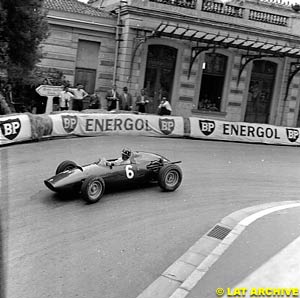 In the 1958 Monaco Grand Prix, a new team made its entry into Formula One. After ten years of practice in the lower rankings of motorsport, Team Lotus made the step into the big league. The drivers for the team were Cliff Allison and Graham Hill, two Britons who were, like the team, making a debut in the Formula One World Championship series. The newcomers did relatively well in practice, as both drivers made it onto the grid - Allison in 13th and Hill in 15th.
In the 1958 Monaco Grand Prix, a new team made its entry into Formula One. After ten years of practice in the lower rankings of motorsport, Team Lotus made the step into the big league. The drivers for the team were Cliff Allison and Graham Hill, two Britons who were, like the team, making a debut in the Formula One World Championship series. The newcomers did relatively well in practice, as both drivers made it onto the grid - Allison in 13th and Hill in 15th.
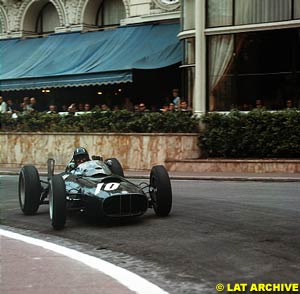 By now, Hill had had more than enough of the unreliability of Lotus and he moved to BRM. For 1960, practice showed a lot more promise than in the Lotus years. Hill put his car sixth on the grid, one spot behind teammate Jo Bonnier and almost a second faster than the third BRM driver, Dan Gurney. However, whatever Hill gained was quickly lost at the start of the race. The Briton got off the line in ninth, but moved up a place very quickly when Wolfgang von Trips dropped back. After a few laps, he made his way past Bristow and Ireland, claiming sixth after ten laps. He remained there until he got in a close fight with Phil Hill and Bruce McLaren. After the dust settled, Hill was in fifth and then fourth, when Jack Brabham retired from the lead. Just after the halfway point, McLaren got past Hill for good and after two thirds of the race Hill spun off and was unable to resume. However, he was classified seventh.
By now, Hill had had more than enough of the unreliability of Lotus and he moved to BRM. For 1960, practice showed a lot more promise than in the Lotus years. Hill put his car sixth on the grid, one spot behind teammate Jo Bonnier and almost a second faster than the third BRM driver, Dan Gurney. However, whatever Hill gained was quickly lost at the start of the race. The Briton got off the line in ninth, but moved up a place very quickly when Wolfgang von Trips dropped back. After a few laps, he made his way past Bristow and Ireland, claiming sixth after ten laps. He remained there until he got in a close fight with Phil Hill and Bruce McLaren. After the dust settled, Hill was in fifth and then fourth, when Jack Brabham retired from the lead. Just after the halfway point, McLaren got past Hill for good and after two thirds of the race Hill spun off and was unable to resume. However, he was classified seventh.
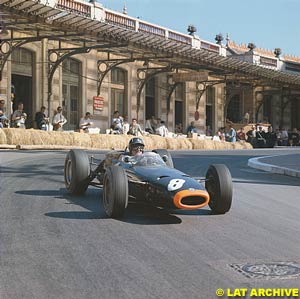 This was not yet meant to be. On the verge of his first Monaco victory, Hill was left stranded, when his engine failed with just ten laps to go. He was classified sixth, but with a victory wiped away so close to the flag, this wasn't much consolation. In the end it wasn't too discomforting, as Graham Hill won his first World Championship that year, by a clear margin over Jim Clark.
This was not yet meant to be. On the verge of his first Monaco victory, Hill was left stranded, when his engine failed with just ten laps to go. He was classified sixth, but with a victory wiped away so close to the flag, this wasn't much consolation. In the end it wasn't too discomforting, as Graham Hill won his first World Championship that year, by a clear margin over Jim Clark.
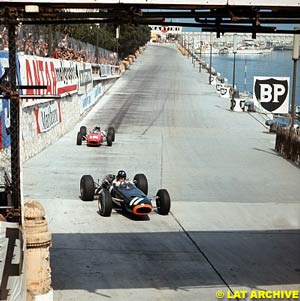 Come 1966, things didn't go as smooth as the years before at BRM. With the 1.5 liter formula now abandoned, the old P261 was fitted with a 1.9 liter V8 engine with which the team was less successful than with its predecessor. However, Monaco proved one final trick for the aging BRM. Graham Hill was slowly starting to feel the pressure of his younger teammate Jackie Stewart, who was rapidly going faster. The Scotsman had already won the Italian Grand Prix during his first season with the team and the new season started with Stewart outqualifying Hill straight away, albeit by a small margin.
Come 1966, things didn't go as smooth as the years before at BRM. With the 1.5 liter formula now abandoned, the old P261 was fitted with a 1.9 liter V8 engine with which the team was less successful than with its predecessor. However, Monaco proved one final trick for the aging BRM. Graham Hill was slowly starting to feel the pressure of his younger teammate Jackie Stewart, who was rapidly going faster. The Scotsman had already won the Italian Grand Prix during his first season with the team and the new season started with Stewart outqualifying Hill straight away, albeit by a small margin.
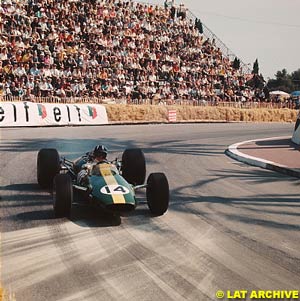 As car after car retired ahead of him, Hill slowly moved into better positions. On lap 82, he moved up into second, though not through joyous circumstances. At the harbour section, Lorenzo Bandini had crashed out and his car had caught fire. As people had seen a large object, believed to be Bandini himself, fly into the harbour, thoughts were initially that the Italian had suffered the same fate as Ascari and Hawkins before: a dive and a swim into the Monaco harbour. Sadly, nothing was further from the truth, since the unfortunate driver was trapped in his vehicle and it was in fact his wheel that had gone into the harbour. Three days later, Bandini died of the burns he suffered in the accident.
As car after car retired ahead of him, Hill slowly moved into better positions. On lap 82, he moved up into second, though not through joyous circumstances. At the harbour section, Lorenzo Bandini had crashed out and his car had caught fire. As people had seen a large object, believed to be Bandini himself, fly into the harbour, thoughts were initially that the Italian had suffered the same fate as Ascari and Hawkins before: a dive and a swim into the Monaco harbour. Sadly, nothing was further from the truth, since the unfortunate driver was trapped in his vehicle and it was in fact his wheel that had gone into the harbour. Three days later, Bandini died of the burns he suffered in the accident.
Please Contact Us for permission to republish this or any other material from Atlas F1.
|
Volume 7, Issue 21
Atlas F1 Special
Interview with Burti
Silly Season Review
Yearly Roar
Monaco GP Preview
The Monaco GP Preview
Tech Preview and Track Map
Focus: Graham Hill at Monaco
Audio: A Lap of Monaco with MS
Columns
The F1 Insider
Elsewhere in Racing
The Monaco Trivia Quiz
Bookworm Critique
Rear View Mirror
The Weekly Grapevine
> Homepage |